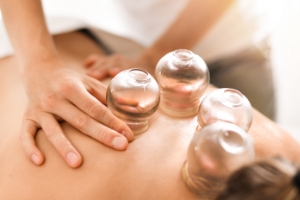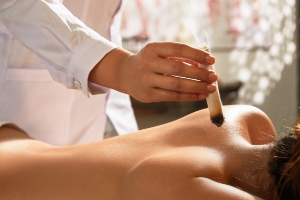No products in the cart.
Back Support (AC)
CLINICAL APPLICATIONS
- Acute low back pain (lumbago)
- Back pain from sports or traumatic injuries, sprains and strains, subluxation
- Back pain due to strenuous exercise or repetitive movements (e.g., grocery checkers/packers, warehouse and assembly line workers, and others in similarly demanding occupations)
- Back pain with inflammation, swelling, or redness
- Chronic back pain with acute exacerbation or re-injury
WESTERN THERAPEUTIC ACTIONS
- Analgesic influence to relieve pain
- Anti-inflammatory action to reduce pain and inflammation
- Muscle-relaxant effect of alleviating muscle spasms and cramps
INGREDIENTS
- Bai Shao (Radix Paeoniae Alba)
- Chuan Niu Xi (Radix Cyathulae)
- Du Zhong (Cortex Eucommiae)
- Ge Gen (Radix Puerariae Lobatae)
- Gui Zhi (Ramulus Cinnamomi)
- Huang Jin Gui (Caulis Vanieriae)
- Ji Xue Teng (Caulis Spatholobi)
- Liu Zhi Huang (Herba Solidaginis)
- Mo Gu Xiao (Caulis Hyptis Capitatae)
- Mu Gua (Fructus Chaenomelis)
- Wei Ling Xian (Radix et Rhizoma Clematidis)
- Yan Hu Suo (Rhizoma Corydalis)
- Zhi Gan Cao (Radix et Rhizoma Glycyrrhizae Praeparata cum Melle)
FORMULA EXPLANATION
Back Support (AC) is explicitly formulated to relieve acute low back pain caused by sports or traumatic injuries, strenuous exercise, repetitive movements, or accidents. Back Support (AC) contains herbs that regulate qi and blood circulation, remove qi and blood stagnation, and relieve pain.
Yan Hu Suo (Rhizoma Corydalis) activates qi and blood circulation and is one of the most potent analgesic herbs to relieve pain. Mo Gu Xiao (Caulis Hyptis Capitatae), Liu Zhi Huang (Herba Solidaginis), and Huang Jin Gui (Caulis Vanieriae) are indigenous Taiwanese herbs that have anti-inflammatory and analgesic properties and are often used to treat acute pain associated with traumatic injuries or sprains and strains. Gui Zhi (Ramulus Cinnamomi) warms the channels, facilitates the flow of qi, and relieves painful obstruction. Ge Gen (Radix Puerariae Lobatae) alleviates muscle tightness. Bai Shao (Radix Paeoniae Alba) and Zhi Gan Cao (Radix et Rhizoma Glycyrrhizae Praeparata cum Melle) nourish the muscles and relieve stiffness and pain in the back. Mu Gua (Fructus Chaenomelis), Wei Ling Xian (Radix et Rhizoma Clematidis), and Ji Xue Teng (Caulis Spatholobi) increase qi and blood circulation to relax the muscles and the tendons. Chuan Niu Xi (Radix Cyathulae) invigorates the blood. Du Zhong (Cortex Eucommiae) is not only a channel-guiding herb to direct the actions of the formula to the lumbar region, but it also has the effect of tonifying and strengthening the back.
These herbs effectively treat acute pain and inflammation affecting the lower back.
Yan Hu Suo (Rhizoma Corydalis) activates qi and blood circulation and is one of the most potent analgesic herbs to relieve pain. Mo Gu Xiao (Caulis Hyptis Capitatae), Liu Zhi Huang (Herba Solidaginis), and Huang Jin Gui (Caulis Vanieriae) are indigenous Taiwanese herbs that have anti-inflammatory and analgesic properties and are often used to treat acute pain associated with traumatic injuries or sprains and strains. Gui Zhi (Ramulus Cinnamomi) warms the channels, facilitates the flow of qi, and relieves painful obstruction. Ge Gen (Radix Puerariae Lobatae) alleviates muscle tightness. Bai Shao (Radix Paeoniae Alba) and Zhi Gan Cao (Radix et Rhizoma Glycyrrhizae Praeparata cum Melle) nourish the muscles and relieve stiffness and pain in the back. Mu Gua (Fructus Chaenomelis), Wei Ling Xian (Radix et Rhizoma Clematidis), and Ji Xue Teng (Caulis Spatholobi) increase qi and blood circulation to relax the muscles and the tendons. Chuan Niu Xi (Radix Cyathulae) invigorates the blood. Du Zhong (Cortex Eucommiae) is not only a channel-guiding herb to direct the actions of the formula to the lumbar region, but it also has the effect of tonifying and strengthening the back.
These herbs effectively treat acute pain and inflammation affecting the lower back.
BACKGROUND
Musculoskeletal and connective tissue injuries lead to over 10 million clinic visits annually in the United States. Causes of these injuries may be external (sports injuries, car accidents, trauma), internal (chronic wear and tear of muscles, ligaments, and tendons; bones weakened by osteoporosis), or both. Acute injuries are characterized by severe pain, swelling, inflammation, and sometimes internal bleeding. Treatment of acute injuries should focus on relieving pain, reducing swelling and inflammation, and stopping bleeding. Chronic injuries are dull pain, stiffness and numbness, and decreased muscle mass and strength. Treatment of chronic injuries includes pain relief and restoration of physical and physiological functions.






